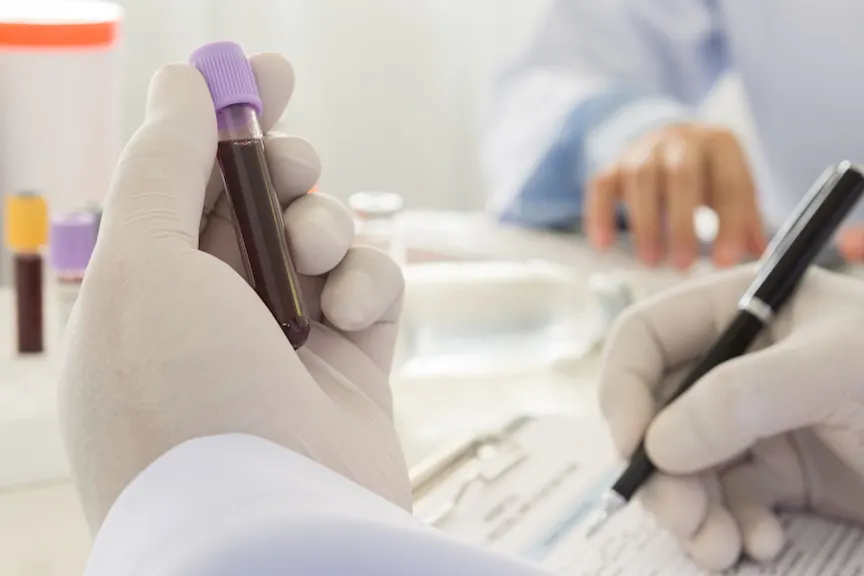Blood Test May Predict Hypertension

Hypertension has traditionallybeen diagnosed by a blood pressure reading of 140/90 mm Hg or higher. Before that threshold is reached, however, undetected blood pressure elevations may have already caused heart damage.
A new version of a blood test used to detect cardiac muscle damage from heart attacks may now also be able to identify a person’s risk of developing hypertension, long before the condition shows up in a blood pressure reading.
The new assay, called the high-sensitivity cardiac troponin-T (hs-cTnT) test, could help doctors intervene early, possibly preventing damage to the heart and other organs.
Detecting hypertension risk
The test used to detect heart muscle damage caused by heart attacks is based on measuring elevated levels of cardiac troponin-T, a protein that is integral to muscle contraction and is released by injured heart cells.
In a 2015 study published in the journalCirculation, Johns Hopkins University researchers found that a more sensitive version of the standard heart attack test could predict whether people would develop hypertension within a few years.
这项研究是基于对血液样本进行分析s taken from 5,479 people enrolled in a long-term research project in the 1980s and early 1990s, which monitored heart disease for an average of 12 years.
The federally funded study showed that people with mild elevations of cardiac troponin-T had a greater risk of developing hypertension within a few years.
Those who had only slightly elevated troponin-T levels—5 to 8 ng/dL (nanograms per deciliter)—had a 13 percent higher rate of hypertension when compared to individuals whose levels were below identifiable ranges on the hs-cTnT assay (less than 5 ng/dL).
Those with higher troponin-T levels—9 to 13 ng/dL—showed a 24 percent increased risk of hypertension, and those with more than 13 ng/dL of troponin-T were nearly 40 percent more likely to develop the disease.
The study also found that the hs-cTnT assay could identify people who were more likely to develop left ventricular hypertrophy, an abnormal thickening of the lower left chamber of the heart, which is commonly caused by untreated high blood pressure.
The risk identified for left ventricular hypertrophy ranged from a twofold increase for people with slightly elevated troponin-T levels—5 to 8 ng/dL—to a fivefold increase for those with troponin-T levels above 13 ng/dL.
Preventing injury
High blood pressure has a gradual onset and varies over time, so a definitive diagnosis requires regular monitoring. It appears that the test could flag people with normal blood pressure in the doctor’s office who are at high risk for hypertension and other poor outcomes.
The researchers said that the test can do so by detecting even trace amounts of troponin released by heart cells injured by spikes in blood pressure that come and go unnoticed, often for years.
If doctors were able to identify patients at risk much sooner, they could recommend lifestyle changes and medication that might prevent damage to the heart, kidneys, brain, and eyes.
Identifying “non-dippers”
One of the benefits of integrating the new blood test into clinical practice is that it can identify patients whose blood pressure fails to drop normally by more than 10 percent during sleep. These patients, known as “non-dippers,” are more likely to have detectable troponin-T levels with the new blood test, something that cannot be measured by standard blood pressure screening.
People known to have this blood pressure pattern can develop silent heart damage before a diagnosis of hypertension occurs.
The new blood test has implications for another group of patients—those who suffer from masked hypertension. These are patients whose blood pressure registers as normal at their physician’s office but whose home or ambulatory levels rise to the hypertensive range.
Masked hypertension affects more than 10 percent of adults and is known to cause organ damage.
Not approved yet by the FDA
While the new blood test has been introduced throughout Europe, the assay is currently not available for clinical use in the United States because it is awaiting approval by the Food and Drug Administration.
In Sweden, widespread adoption of the test has resulted in the identification of a larger number of patients with minor increases of cardiac troponin-T levels.
在瑞典hosp接受治疗的48594名病人的研究itals for acute coronary diseases showed that the test could also predict heightened mortality risk in patients with elevated levels of high-sensitivity cardiac troponin-T.
The hs-cTnT blood test may be beneficial for non-dippers and patients with masked hypertension who are prone to developing structural cardiac damage from their erratic blood pressures.
Those patients often progress to full-blown hypertension within a few years, but may remain undiagnosed and untreated until they have overt symptoms.
If the test’s reliability as a screening tool is confirmed by further study and the FDA approves it, those patients will no longer need to wait until symptoms develop to start taking preventive measures as needed, including undergoing more frequent monitoring to protect their health.
Learn more about how to tell if you have hypertension.





